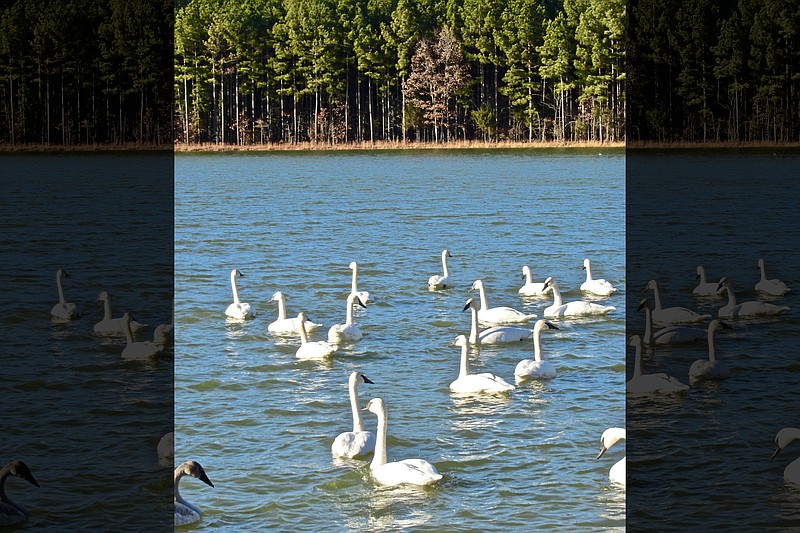MAGNESS LAKE — With so much of normal life still canceled or postponed, Arkansas is blessed once again by the seasonal return of magnificent trumpeter swans from the Upper Midwest.
A couple hundred or more of America's largest waterfowl, with wingspans up to 8 feet, are spending their 29th straight winter at Magness Lake and two nearby unnamed lakes in Cleburne County, a half-dozen miles east of Heber Springs. They arrive each November before migrating back north in late February.
Their energetic takeoffs bring to mind a seaplane straining to make it aloft. Once airborne, they swoop as gracefully as a glider. The chance to see a sight so grand is a genuine treat, the more so given the threat to wildlife everywhere on a planet now packed with nearly 8 billion human beings.
Nearly driven to extinction a century ago, the white-feathered aquatic birds today number an estimated 35,000, mostly in the Upper Midwest and Mountain states. Cleburne County is the farthest south they've been known to travel. They are best seen from midafternoon to dusk, after returning from feeding elsewhere.
The owners of Magness Lake, where the first three wintering trumpeters were spotted in 1992, permit access to the viewing site with free parking at a bend on Hays Road next to the lake. Only a waterfront wire fence separates fascinated humans from the big birds, who often mingle with one or more duck species.
Missing from the site this winter are two signs that carried information about the swans, as well as cautions about visiting. The white adults, known as cobs if male and pens if female, weigh up to 40 pounds. The juveniles, called cygnets, have gray or brown plumage patches on their white background. Adult trumpeters usually mate for life and typically stay together with three or four cygnets.
There are usually more trumpeters at the nearby unnamed lakes, whose owner has placed corn feeders on the shoreline of the 22-acre and 14-acre bodies of water. There are no fences, and the swans are somewhat used to photo-snapping humans. Courtesy and common sense should persuade visitors to keep a respectful distance. As at Magness Lake, pets must be kept in vehicles. The swans should never be touched.
While there is now a sizable U.S. population of trumpeters, and more in Canada, their future is not assured. Perils include loss of habitat, as well as lead poisoning from shotgun pellets, which the swans may mistake for stones and swallow to help with digestion of hard grains. Their uncertain fate is another reason to visit the lakes sometime this month or next.
Seeing the swans
◼️ To visit Magness Lake, drive east for 4 miles on Arkansas 110 from its intersection just east of Heber Springs with Arkansas 5/25. Turn left on Hays Road to reach the lake's parking and viewing area in about a half-mile.
◼️ For the unnamed lakes, go about 2 ½ miles east on Arkansas 110 from the Arkansas 5/25 intersection. Turn right on Hiram Road, marked with a small “Swans” sign to reach the first lake in about 4 miles at a narrow lane and the second in another mile.
◼️ Heber Springs Chamber of Commerce may have updates on the presence of the trumpeter swans. Visit heber-springs.com or call (501) 362-2444.

